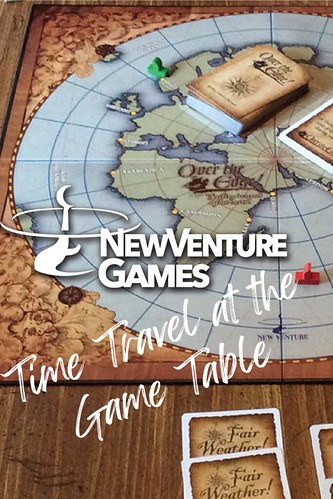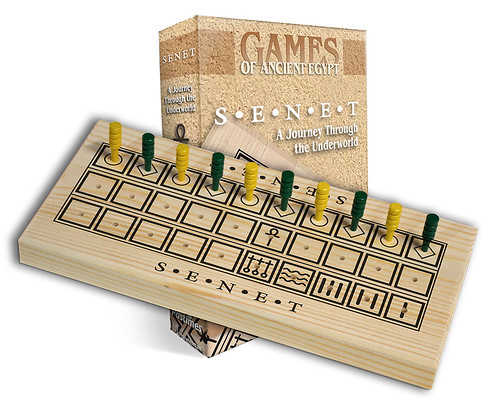One of my favorite bands from my youth was The Moody Blues (still is). They were the champions of “concept albums” - collections of songs, poetry, and instrumental pieces that told a story or addressed an idea through music. The relevant quote that comes to mind is taken from their album “In Search of the Lost Chord” from 1968.
“Thinking is the best way to travel.”

While that notion might be contested, the point that songwriter Mike Pinder was trying to convey is that “travel” is more than a geographical phenomenon, but also applies to journeys into other social paradigms, points of view, cultural experiences…and even other times.
Wearing clothes of a different culture, eating foods from regions other than our own, learning a foreign language, or experiencing arts of a bygone age are all ways to “travel” to other times and climes. And the games people play are a very personal and dynamic vehicle in this journey—sort of a playful time machine.
The Peg Pastimes series of games that we create at NewVenture Games are reproductions of historic and traditional strategy games from around the world. This includes games as old as recorded history, such as the Royal Game of Ur (a Sumerian board game over 5,000 years old) to board games of the Victorian era, reflecting the social norms and attitudes of only 120 years ago.
Guiding a student through the mechanics of a board game—how pieces move, how strategies can be devised, and ultimately how to win the game—are only the face of the game. But looking further into the cultural story that the game tells us, and the context in which it has been played…that’s where the treasure lies!
Take for example the game of Senet, rediscovered by archeologists in the early 20th century. Game historians recognize it as a race game, with either captures or setbacks in the rules which make it more competitive. But the game has also been called “the Journey through the Underworld,” and as such it embodies ideas and symbolism from the spiritual life during the Egyptian 12th Dynasty. The game was played by Tutankamen and Nefertiri in the Royal Courts of the Pharaohs, and these games were included in Royal tombs to accompany the dead in the afterlife. More than simple recreation, the game embodied the essence of their spiritual values, and may have been seen as a method of divination as well. The methods and materials of manufacture even tell us about what their culture valued.

A more recent game in the collection comes from Madagascar, taken very seriously within that Kingdom’s cultural heritage. The roots and age of the game are lost in the fog of history, but it is surely many centuries old. According to an ancient legend, an astrologer advised King Ralambo to choose his successor by selecting a time when his sons were away from the capital, then feign sickness and urge their return. His kingdom would be given to the first son who returned home to him. When the king’s messenger reached Ralambo’s elder son Prince Andriantompokon-drindra, he was playing Fanorona and trying to win a telo noho dimy (3 against 5) situation, one that is infamously difficult to resolve. As a result, his younger brother Prince Andrianjaka was the first to arrive and inherited the throne.

The game of Hare and Hounds links us to France in the 1870s. The earliest evidence of this simple but challenging puzzle game is found on the battlefields of the Franco-Prussian war. It was a short conflict, but significant in the political landscape in the region. The story goes that the game was devised by the sooldiers as a way to pass the time those precious moments when the fighting subsided. It was originally referred to in English as “the French Military Game” for obvious reasons. The soldiers took the game home with them and it became a popular pastime in many households. The game reached England within a decade, and the growing board game industry there snatched up the design immediately. The publishers recast the game’s conflict to the English hunting sports and the French and Prussian soldiers became the Hare and Hounds we know today. Two quite different environments that can be touched through one simple parlor game.

The role of the interpreter of history is to open these doors to other worlds, and to guide the players of the games on these journeys. Imagine other worlds of sights, sounds, and smells—the way the clothes fit, the snacks at the table, the manners and feelings that come to the game table. It’s a whole ‘nother place that we have travelled to.
Find NewVenture Games online at:
www.newventuregames.com
https://www.facebook.com/NewVentureGames
https://www.youtube.com/NewVentureGames
As a graphic designer, David McCord has worked for 50 years in agencies, corporate environments, and as a freelancer. His specialty is technical illustration and document design, but has experience with displays, packaging, corporate identity and publications as well.
As educator, David has conducted many workshops and been guest lecturer for graphic design and media classes, taught music and drawing classes, and currently serves as chairman of the advisory board for the Montcalm County Career Center Digital Arts program.
As a gamer, his collection of board games is quickly approaching the 2,000 mark. He has designed dozens of board and card games, and over the past few years has embarked on a serious project to bring traditional and historic games to market. This series, called the Peg Pastimes, includes over 50 strategy games, and more in the works for 2023.
All photos courtesy and copyright NewVenture Games, published with permission
